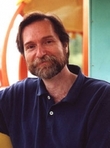FBR 94: Taking just a moment . . .
. . . to look through Seamus Heaney's new volume, Human Chain, we settle on "Miracle," a quiet gloss on Mark 2: 1-12. The scripture story concerns "one sick of palsy, which was borne of four" to a house in Capernaum where Jesus was speaking. "When they could not come nigh unto him for the press, they uncovered the roof where he was: and when they had broken it up, they let down the bed wherein the sick of the palsy lay." Jesus heals the man, saying, "Arise and take up thy bed, and go thy way into thine house. And immediately he arose, took up the bed, and went forth before them all. . . ."
Heaney's poem seem to me to number several miracles. He takes in this episode as if he were a part of that human press outside the house, and the fact of his perspective in the crush of the crowd is one of his points. Jesus is not mentioned. As one of the crowd, he likely would not have seen him. He may have seen, briefly, the palsied man. These are singular sightings at the heart of the Gospel story, but they are participants in only one of the miracles here. What one of the crowd would have seen, and for some time, since they are on the roof, are the "four."
He begins,
Not the one who takes up his bed and walks
But the ones who have known him all along
Beginning with a negation, Heaney recasts the familiar scene. Its actors are no longer who you think of when you hear this story. Neither Jesus nor the healed man, but the others, who Mark characterizes for us simply as a number. Heaney sees in them the center, or one center, of another story, and he gives them life. As the ones who have known him all along, they are, simply, the sick man's friends.
Their shoulders numb, the ache and stoop deadlocked
In their backs, the stretcher handles
Slippery with sweat.
These men are made real. Perhaps this is another of the miracles of the poem, Heaney's conjuration. Anyone who has carried a stretcher knows what it feels like in the shoulders and back; anyone who has rolled a wheelbarrow knows what it feels like. And the handles, yes, there is sweat; we all know that.
But there is so much — of human and divine importance — going on here, why take the time to make these four men real? I think it's to prepare us to apprehend what may be the real miracle taking place in Capernaum that afternoon.
Heaney continues and ends:
Be mindful of them as they stand and wait
For the burn of the paid-out ropes to cool,
Their slight lightheadedness and incredulity
To pass, those ones who had known him all along.
"Be mindful." A biblical construction. A commandment of its own. But so subtle, is it not? Simply, be aware of those who had known him all along. Who suffered to bring him here to make him whole. Those men are the miracle. The friends who carry you when you are a burden. Those who will gently strap you tight, lower you for healing, their hands burning, who will stand and wait on the roof for you.
Acknowledging these four men, knowing that they have not been healed, allows the viewer on the one hand to see in simple friendship perhaps the most enduring miracle of that — or any other — day. On the other hand, in pointing to those who take on burdens and suffer quietly, Heaney is gently reminding us of the healer unmentioned in his poem, but who is at the center of Mark's story.
Tony Abbott's Blog
- Tony Abbott's profile
- 402 followers



